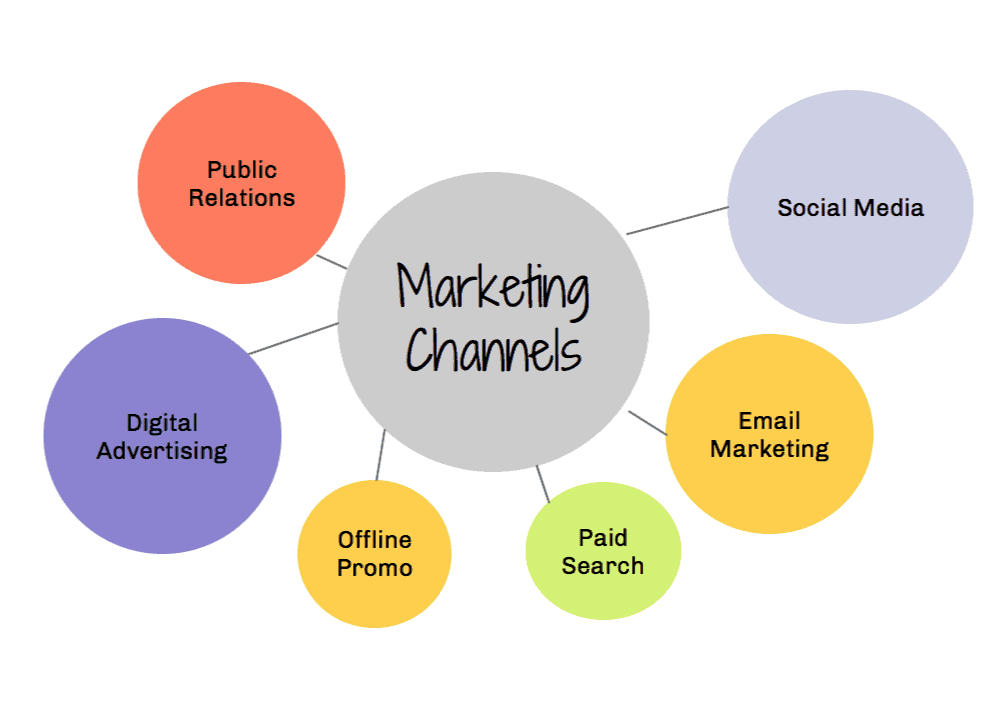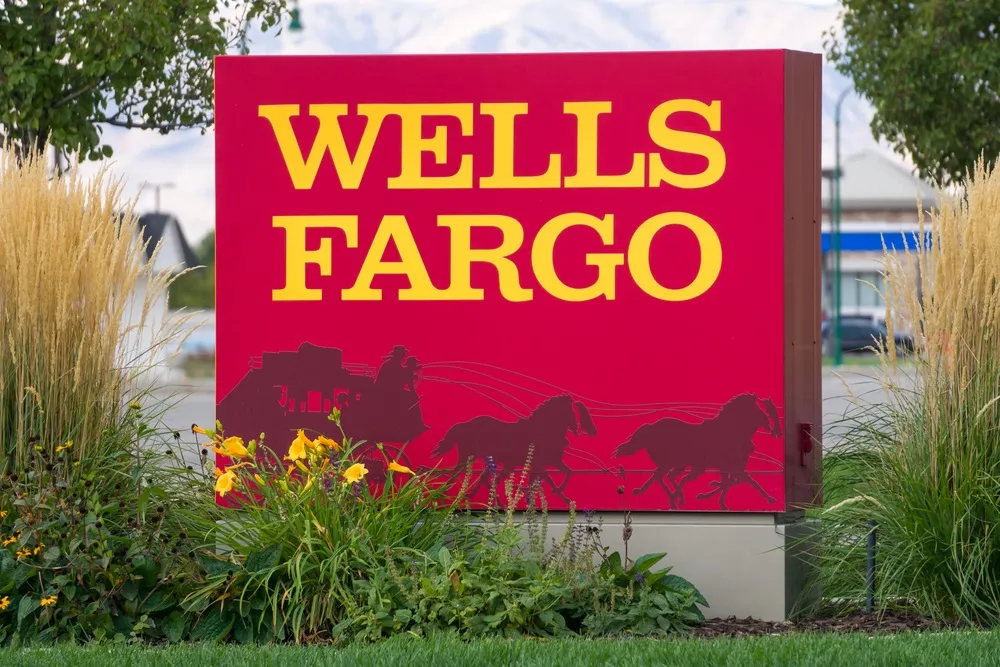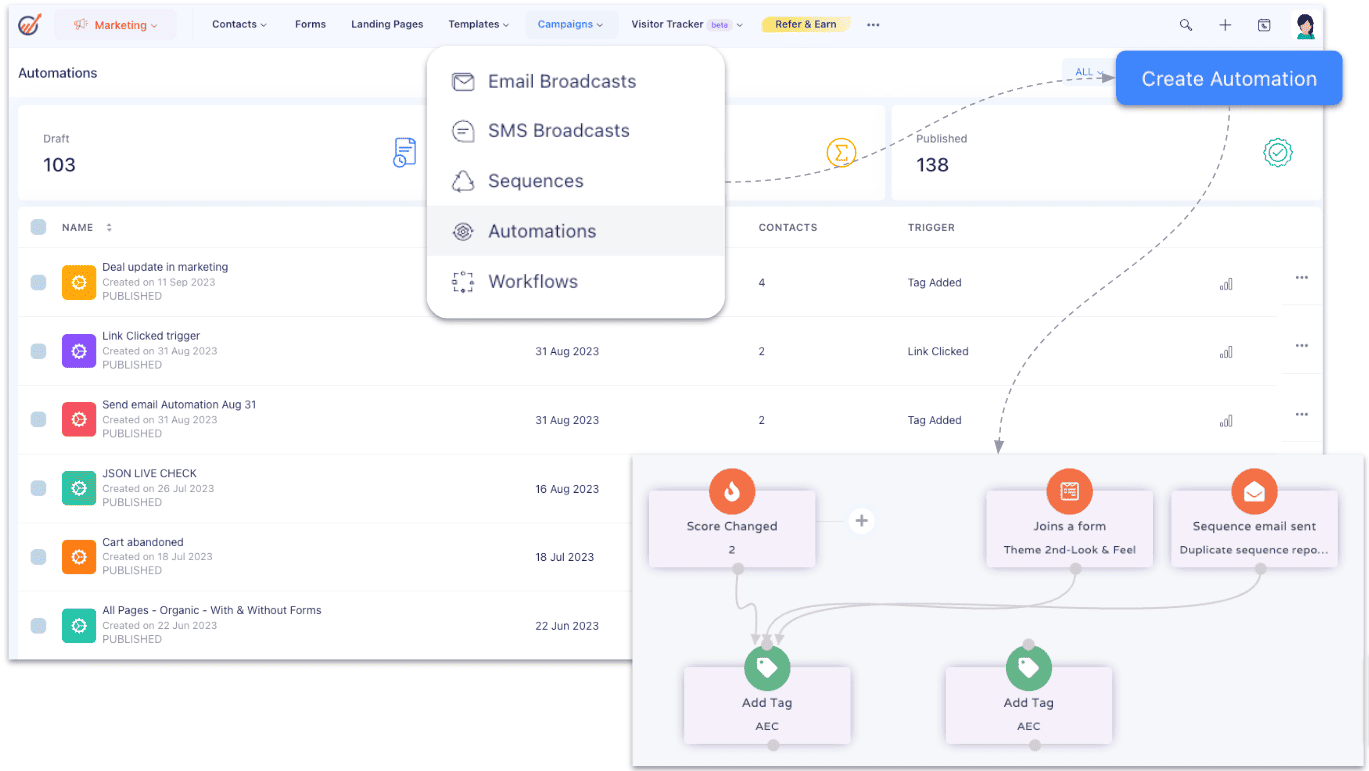Multichannel marketing involves running targeted campaigns across multiple platforms to reach a wider audience. However, you may run campaigns inefficiently if your channels don’t work in sync. Regardless of the media your company adopts, an effective integrated marketing strategy will provide your customers with a unified and consistent brand experience.
Like every other marketing strategy, integrated marketing aims to grow your brand’s visibility and reach. In this article, we share the following:
- Benefits of integrated marketing
- Practical strategies for integrated marketing
- Examples of integrated marketing by excellent brands
Table of Contents
What Is Integrated Marketing?
Integrated marketing is an approach that ensures the consistent, unified, and seamless delivery of brand messages across multiple channels. It uses unique branding techniques and multichannel marketing across digital and traditional media to create a unified customer experience. Ultimately, it involves using direct and indirect marketing tactics to fuel engagement.
Imagine browsing your phone and spot an ad from a fashion brand promoting its newest products. The ad was designed with their brand color and tagline, using a simple font style. As you stepped out, moving to the nearest coffee shop, you saw a billboard with the same advert. Finally, you decide to chat with a friend on Facebook, and the ad pops up again with a similar ad design and message.
Naturally, the fashion company has succeeded in creating a consistent and unified brand message across all three marketing channels. So, you can easily recognize the brand when they run their next campaign, regardless of the platform they use. However, this may not be the case if they had given a disjointed brand experience with different messaging across those channels.
Integrated marketing gives a brand its unique identity, irrespective of the platform or channel it adopts.
What’s the Difference Between Integrated Marketing and Omnichannel Marketing?
Integrated marketing focuses on customer communications and uses tactics that make brand storytelling consistent across multiple channels. It unifies web content, sales ads, social posts, and other forms of marketing communications to create a unique and memorable customer experience.
On the other hand, omnichannel marketing focuses on the customer journey and aims to create a seamless and optimized customer experience, irrespective of the chosen channel. Although it provides consistent messaging across multiple channels, it promotes seamless engagement and creates personalized experiences using customer actions and brand interactions.
Both forms of marketing use a multichannel approach to communicate and interact with customers. So, integrated marketing communications uses multiple channels to make your brand message consistent. Omnichannel marketing ensures your customers have seamless experiences, regardless of the channels they use to interact with you.
Read also: Cross-Channel Marketing: What You Need to Know
Benefits of Integrated Marketing
Whether you’re a small or large business, unifying your marketing campaigns across all channels gives your company several advantages.
1. Increased brand awareness
Running strategic campaigns across multiple channels puts your brand in front of your customers, regardless of the platform they use. As you use consistent messaging across these channels, you can boost your brand recognition and awareness.
Usually, customers will remember a brand easily when they see it regularly at different strategic places (print, digital, audio, etc.).
2. Reduced cost
Promoting campaigns with different messaging can increase your marketing expenses, as you’d have to spend resources creating new content for each platform. But with integrated marketing, you can repurpose one content piece and share it across all suitable channels.
This tactic helps you manage your marketing budget and reduce costs, and you don’t have to create new campaigns for every channel your brand adopts.
3. Improved brand uniqueness
Integrated marketing gives your brand a unique identity that makes it stand out. It ensures your strategies and campaigns are optimized to match your style and reflect your message.
For example, consistency with your brand colors and tagline across all marketing channels will allow your customers to recognize what sets you apart from your competitors.
4. Increased brand loyalty and trust
When customers get familiar with your brand style and tone, they are more likely to become repeat buyers because they trust your consistency. Usually, customers will freely buy from a brand they recognize. And when your branding is unified, they’re clear about what your offers represent.

5. Improved customer experience
A multichannel approach targets users on several platforms. But when your message becomes consistent across these channels, customers get familiar with your brand and can easily understand what you do.
They have a pleasant experience since they’re clear about what you offer or what your brand represents.
6. Increased revenue
Integrated marketing has an indirect impact on your company’s revenue. As your brand becomes more visible, you’ll experience increased sales and overall business growth.
Additionally, having a seamless unified campaign across multiple platforms creates pleasant customer experiences. This can boost your income by turning new shoppers into repeat buyers.
Read also: All the Basics of Omnichannel Marketing (+Examples, Tips)
How To Build an Integrated Marketing Campaign
Several techniques exist for creating effective integrated marketing campaigns, so companies usually adopt strategies that suit their business model and goals. However, there are a few general tactics that all brands can employ and tailor according to their needs to achieve the desired results.
The integrated marketing communications strategies include the following:
- Craft your campaign goal
- Identify your target audience
- Define your USP
- Choose your preferred marketing channels
- Assign specialists to manage each channel
- Create timely and relevant assets
- Create a lead generation plan
- Monitor your performance and analyze results
1. Craft your campaign goal
From launching a new product to boosting brand awareness, rebranding, making announcements, etc., you may have one or more goals you want to achieve with your digital marketing campaigns. So, the first step towards creating an integrated marketing strategy is defining the goals and objectives of your business.
These goals revolve around your brand model, needs, and values. For example, if you’re a new sports company and your primary goal is to improve your brand visibility across major platforms, you’d focus more on increasing your traffic and employing tactics that lead to more page views.
2. Identify your target audience
Different products and branding techniques appeal to different consumers. While it’s crucial to create attainable goals, it’s also essential to tailor them to the right audience. You can define your target audience by conducting market research to find individuals who are interested in your offers. Communicating with your audience using the right message can help your campaigns and make your customers understand your intent.
Your target audience defines your strategy, marketing channels, content types, and other forms of marketing that distinguish your brand from the crowd. Understanding your target audience also helps you identify their pain points and other vital data you could use to streamline your campaigns.
3. Define your USP
Your unique selling proposition separates you from the clutter and gives you a brand identity. Before running your marketing campaigns, it’s essential to identify what sets your brand apart from the competition. This makes you stand out and capture the interest of your visitors.
You can find your USP by performing competitive research to see what your competitors are doing. You can gather customer reviews to understand their pain points and create a unique strategy to provide solutions tailored to their needs.
Incorporating your USP into your brand messaging and values helps you build an unparalleled integrated marketing campaign.
Read also: Mastering Brand Storytelling: Strategies and Examples
4. Choose your preferred marketing channels
Integrated marketing uses a multichannel approach, cutting across digital and traditional marketing. From TV commercials to social media and emails, the channel you choose depends on several factors, such as budget, business goals, target audience, brand values, etc.
Knowing how each channel works is critical to maximizing it to build awareness and increase conversions. Some of these channels may include:
- Email marketing
- Public relations (PR)
- Social media
- Print media
- Search engine marketing (SEM)
- Display ads
- Content marketing
- TV commercials
- Event marketing
- Billboard marketing
Outlining the most suitable channels for your business will help you create specific marketing techniques for creating and distributing your brand assets. You should only use the number of channels you can handle within a given timeline. Too little will limit your reach, and too many will overwhelm your team.

5. Assign specialists to manage each channel
Since you run your campaigns on multiple channels, managing them alone will overwhelm you and decrease efficiency. Ideally, appointing managers to coordinate your marketing campaigns across different channels would be best.
The size of this team depends on the size of your business and the number of channels you use. Each channel has a specific mode of operation, so these specialists will know how to optimize each content to suit the campaign. Also, they will monitor the performance of these campaigns, analyze reports, and provide opportunities for adjustments or improvement.
As you start your campaigns, these managers will use your brand values to tailor their strategies and craft consistent messaging across your preferred platforms.
6. Create timely and relevant assets
Your channel specialists will depend on your primary brand assets for content production and distribution. From there, they can then repurpose them into different formats to suit the channel they manage. From blog posts to videos, quotes, taglines, e-books, GIFs, images, etc., you can unify your message and create unified marketing campaigns.
These assets also include your brand content guidelines and specific templates, as they will help your team maintain an integrated approach, irrespective of the channels. Creating timely and relevant brand assets involves using defined strategies to craft appropriate content to match your brand goals and target your customer’s pain points.
7. Create a lead generation plan
Whether you’re building your brand visibility, promoting your product, or making an update, it’s necessary to have a plan for capturing new visitors. Integrating multiple systems will require different strategies for generating leads depending on your brand goals or preferred channel.
You can lead them to subscribe to a newsletter, create an account, download your blueprint, watch a webinar, or even make a purchase. Whichever way, you need a plan to generate new and nurture new leads. These strategies will help you decide how to make the journey seamless for your users, regardless of their channel.
8. Monitor your performance and analyze results
Once you’ve launched your campaign, you may only know what’s happening if you track your performance over time and analyze the results. Since you have your goals, you can quickly tell if you’re winning or not.
Generally, every channel has a different mode of operation, so brands would usually monitor each channel separately to see which performs best. Several industry benchmarks help you know if you should make adjustments, add new strategies, or do nothing.
Monitoring your integrated marketing campaigns with the right metrics lets you spot loopholes in your strategies and helps you make necessary improvements for future campaigns. It also allows you to see the top-performing channels so you can focus your marketing efforts to yield more positive results.
Read also: Everything You Need to Know About CRM Integration
Examples of Integrated Marketing Campaigns From Top Brands
You can improve your tactics by learning from top brands that have carried out successful integrated marketing campaigns. The examples show the campaigns and strategies these brands employed to achieve positive results.
1. New York Times: The Truth is Hard
The New York Times launched a multi-media campaign in 2017 with the slogan, “The Truth is Hard.” The campaign first shows a pain point that describes how difficult it is to access reliable and authentic information. It then reveals the New York Times as a solution, a trusted source for independent and trustworthy journalism.
The campaign won the INMA Global Media Awards “Best in Show.” The entry stated, “In a world of fake news and misinformation, we wanted to reinforce The New York Times was going to stand for the truth. We wanted to cut through with an elegant reminder that the truth and independent journalism are more important now than ever. We also wanted to communicate that The New York Times was a trusted source in a time when the concept of truth is up for debate.”
The brand used print, social, PR, earned media, digital, event marketing, etc., with the same message across these channels. This resulted in a 100% increase in subscriber base, 20 million views across YouTube, Facebook, and Twitter, and many more significant results that gave The New York Times an edge over their competitors.
2. Wells Fargo: This is Wells Fargo

Wells Fargo, a financial service company in the United States, launched an integrated marketing campaign in 2019 called “This is Wells Fargo.” It aimed to introduce a new visual identity, as it had suffered crises, multiple scandals, and fraud claims. So, the campaign’s primary goal was to improve customer experience and re-establish the brand as a reputable bank.
Wells Fargo used multiple channels to reach their target audience, describing how certain improvements can help the company rebuild trust and deliver exceptional customer service. The campaign reveals several features, like Control Tower, which provides customers simple, secure, and centralized access to their cards and account information.
Moreover, the financial services company curated a playlist to provide customers with crucial financial information and rebuild customer trust. The marketing tactic emphasized the combination of reliable technology with human perception.
According to the CEO and President Tim Sloan, “Our goal of delivering exceptional service to customers and helping them succeed financially remains central to everything we do. As customer expectations continue to evolve, this campaign highlights that Wells Fargo is transforming to provide easier, more personal, and helpful solutions.”
3. Nike: Breaking2
Nike, a footwear and apparel corporation in the United States, launched a thrilling campaign to promote the unique capabilities of their new product, Nike Zoom Vaporfly Elite. It is a running shoe designed with special materials to improve athletes’ performance on track by reducing weight and maximizing aerodynamics.
The “Breaking2” campaign attempted to break the two-hour barrier to running a marathon. Nike invited three athletes – Eliud Kipchoge, Zersenay Tadese, and Lelisa Desisa – for the race and streamed the marathon live on their major platforms with the hashtag #Breaking2.
The campaign sparked lots of reactions from the audience, and although the two-hour goal still needed to be achieved, Eliud made history, as he reached the finish line in two hours and 25 seconds, marking the fastest marathon in history.
The campaign aimed to show the possibilities when cutting-edge technology meets passion and commitment. Nike Zoom Vaporfly Elite was designed keenly with specifications necessary for runners to perform at peak efficiency. The live broadcast received about 5.3 million views on Facebook and over half a million on YouTube. They also had a custom Nike Vaporfly Elite shoe emoji on Twitter.
4. O2: Be More Dog
O2, a telecommunications services provider in England, launched the “Be More Dog” campaign in 2013. It was an attempt to change the customer perception of the brand by opening up technology’s possibilities to everyone.
The campaign contrasts the calm and cold character of the cat with the more energetic and enthusiastic nature of dogs. They encouraged their audience, using strategic marketing channels and refined tactics, to be more adventurous and “more dog.”
The results showed over 50,000 online conversations with over 1 million visits to its campaign pages online. It also gained more shares on social platforms like Facebook, Twitter, and Instagram, as users tried to challenge internet cattishness and nudge everyone online to “be more dog.”
Read also: Data-Driven Marketing Automation For Maximum Impact
Final Takeaway
Integrated marketing allows businesses to reach a wider audience, regardless of the platforms they use. As you repurpose your content to fit each platform, you can deliver relevant and timely offers while keeping your message consistent and unified.
With a disjointed brand experience, customers may find it hard to understand what you offer and how they can benefit from your products or services. However, the strategies in this article can help you coordinate your channels to ensure seamless and unified marketing campaigns.
EngageBay is a software solution designed to solve the problem of disintegrated marketing — EngageBay has an all-in-one approach to marketing, with a built-in CRM suite to complement your marketing automation. Try it for free.

